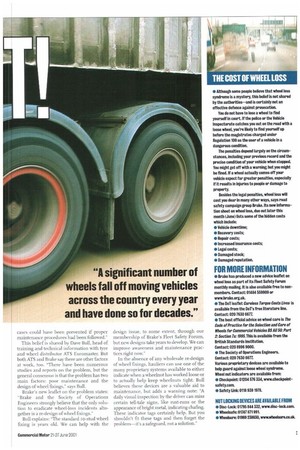When wheels fly from an HO, the threat to life
Page 34

Page 35

If you've noticed an error in this article please click here to report it so we can fix it.
and limb is obvious. The jury is out when it comes to the causes of loose wheels on trucks but, as David Taylor reports, the canny haulier can take precautions to reduce the chances of disaster striking...
T he thought of a vehicle's wheel
working loose, breaking free and careering down the motorway to cause mayhem and destruction is enough to make any fleet manager break out into a cold sweat—and the company's
lsurer could have a sleepless night too. The hrase "lost wheel syndrome" sets this prob!rn apart from other major mechanical failres, most of which are easy to attribute to pecific causes and most of which can be fore en avoided. But in describing this prob1-n as a syndrome we give it an air of special ienace, like some unavoidable and entirely indom illness that can strike even the most ealthy and conscientious haulier.
But, although the problem of loose wheel mdrome is widely misunderstood, the otion that its cause is in some way beyond Lir control is itself a misunderstanding. The ,epartment of Transport certainly does not lbscribe to this view. "There has been a lot of search into the problem of wheel loss, hich is why it is not a mystery", says the DoT ivice leaflet Careless Torque Costs Lives.
Hauliers, being a generally pragmatic lot, so have a shrewd idea of why wheels work loose. Many regard the "mystery" of the syndrome as a cop-out.
"There have been all sorts of stories about how everything was in perfect condition and done up tight... but who knows?" says Colin Hogg, fleet engineer with Newcastle upon Tyne-based general haulier Murray Hogg. "It's quite a convenient phrase, isn't it, 'loose wheel syndrome'?"
Hogg reports that none of Murray Hogg's 85 vehicles has ever actually lost a wheel in transit (at least not in the zo years he's been there). But he admits that wheel nuts can work loose. "My feeling is that it's down to dirty wheel faces. There's a build-up of rust and scale between the wheel and the hub which you disturb when you take the wheel off. When you replace the wheel the rust slowly crumbles and the wheel works loose," Hogg explains.
"We're no different to anyone else and occasionally you find a wheelnut's worked loose. But we find that it happens mainly on the older vehides. Now we always give wheel-facings a good wire-brush before re-fitting the wheels... lost wheel syndrome really isn't something we have trouble with."
Not all hauliers can say the same. Road safety campaign group Brake says: "A significant number of wheels fall off moving vehicles across the country every year and have done so for decades." Brake cites two recent statistics: over a two-month period the Vehicle Inspectorate recorded 303 cases of loose wheels where a prohibition notice was issued. And over a period of three months the Association of Chief Police Officers recorded 124 incidents of wheel problems, including 92 where the wheel actually came off the vehicle. In 35 of these cases the lost wheel caused an accident and in four cases, injury resulted.
"We believe the main cause of wheel loss is poor maintenance, more than anything else," says Lynne Holden, marketing officer for Brake's Fleet Safety Forum. "Many of these cases could have been prevented if proper maintenance procedures had been followed."
This belief is shared by Dave Bull, head of training and technical information with tyre and wheel distributor ATS Euromaster. But both ATS and Brake say there are other factors at work, too. "There have been numerous studies and reports on the problem, but the general consensus is that the problem has two main factors: poor maintenance and the design of wheel fixings," says Bull.
Brake's new leaflet on the problem states: -Brake and the Society of Operations Engineers strongly believe that the only solution to eradicate wheel-loss incidents altogether is a re-design of wheel fixings."
Bull explains: "The standard o-stud wheel fixing is years old. We can help with the
design issue, to sonic extent, through our membership of Brake's Fleet Safety Forum, but new designs take years to develop. We can improve awareness and maintenance practices right now."
In the absence of any wholesale re-design of wheel fixings, hauliers can use one of the many proprietary systems available to either indicate when a wheelnut has worked loose or to actually help keep wheelnuts tight. Bull believes these devices are a valuable aid to maintenance, but adds a warning note: "A daily visual inspection by the driver can miss certain tell-tale signs, like rust-runs or the appearance of bright metal, indicating chafing. These indicator tags certainly help. But you shouldn't fit these tags and then forget the problem—it's a safeguard, not a solution."
































































































